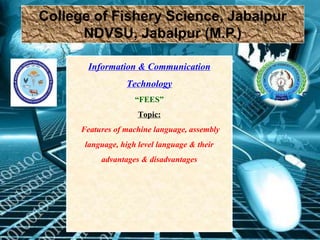
Features of machine language, assembly language, high level language & their advantages & disadvantages
- 1. College of Fishery Science, Jabalpur NDVSU, Jabalpur (M.P.) Information & Communication Technology “FEES” Topic: Features of machine language, assembly language, high level language & their advantages & disadvantages
- 3. Low-Level Languages: A language that corresponds directly to a specific machine High-Level Languages: Any language that is independent of the machine There are also other types of languages, which include:- System languages: These are designed for low-level tasks, like memory and process management Scripting languages: These tend to be high-level and very powerful Domain-specific languages: These are only used in very specific contexts Visual languages: Languages that are not text-based Esoteric languages: Languages that are jokes or are not intended for serious use
- 5. Low-level computer languages are either machine codes or are very close them. A computer cannot understand instructions given to it in high-level languages or in English. It can only understand and execute instructions given in the form of machine language i.e. binary. There are two types of low-level languages: Machine Language: a language that is directly interpreted into the hardware Assembly Language: a slightly more user-friendly language that directly corresponds to machine language
- 6. Machine language is the lowest and most elementary level of programming language and was the first type of programming language to be developed. Machine language is basically the only language that a computer can understand and it is usually written in hex. In fact, a manufacturer designs a computer to obey just one language, its machine code, which is represented inside the computer by a string of binary digits (bits) 0 and 1. The symbol 0 stands for the absence of an electric pulse 1 stands for the presence of an electric pulse.
- 7. Advantages Disadvantages Machine language makes fast and efficient use of the computer. All operation codes have to be remembered It requires no translator to translate the code. It is directly understood by the computer. All memory addresses have to be remembered. It is hard to amend or find errors in a program written in the machine language.
- 8. Assembly language was developed to overcome some of the many inconveniences of machine language. This is another low-level but very important language in which operation codes and operands are given in the form of alphanumeric symbols instead of 0’s and l’s. These alphanumeric symbols are known as mnemonic codes and can combine in a maximum of five-letter combinations e.g. ADD for addition, SUB for subtraction, START, LABEL etc. Because of this feature, assembly language is also known as ‘Symbolic Programming Language.' The instructions of the assembly language are converted to machine codes by a language translator and then they are executed by the computer.
- 9. Advantages Disadvantages Assembly language is easier to understand and use as compared to machine language. Like machine language, it is also machine dependent/specific. It is easy to locate and correct errors. Since it is machine dependent, the programmer also needs to understand the hardware. It is easily modified.
- 10. High-level computer languages use formats that are similar to English. The purpose of developing high-level languages was to enable people to write programs easily, in their own native language environment (English). High-level languages are basically symbolic languages that use English words and/or mathematical symbols rather than mnemonic codes. Each instruction in the high-level language is translated into many machine language instructions that the computer can understand.
- 12. Advantages Disadvantages High-level languages are user-friendly A high-level language has to be translated into the machine language by a translator, which takes up time They are easier to learn They are easier to maintain They are problem-oriented rather than 'machine'-based A program written in a high-level language can be translated into many machine languages and can run on any computer for which there exists an appropriate translator The language is independent of the machine on which it is used
- 13. Types of High-Level Languages 1) Algebraic Formula-Type Processing These languages are oriented towards the computational procedures for solving mathematical and statistical problems. Examples include: BASIC (Beginners All Purpose Symbolic Instruction Code) FORTRAN (Formula Translation) PL/I (Programming Language, Version 1) ALGOL (Algorithmic Language) APL (A Programming Language) 2. Business Data Processing These languages are best able to maintain data processing procedures and problems involved in handling files. Some examples include: COBOL (Common Business Oriented Language) RPG (Report Program Generator) 3. String and List Processing These are used for string manipulation, including search patterns and inserting and deleting characters. Examples are: LISP (List Processing) Prolog (Program in Logic) 4. Object-Oriented Programming Language In OOP, the computer program is divided into objects. Examples are: C++ Java 5. Visual Programming Language These programming languages are designed for building Windows-based applications. Examples are: Visual Basic Visual Java Visual C
